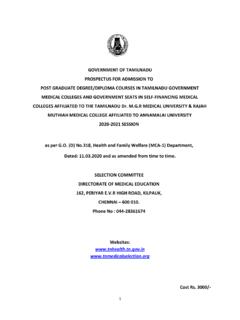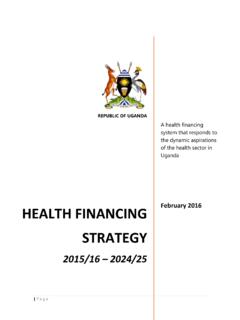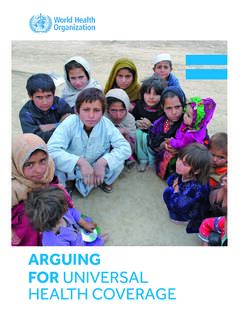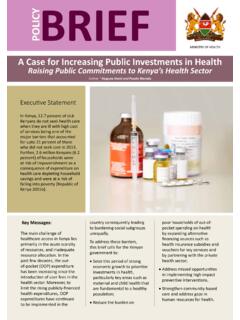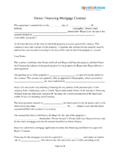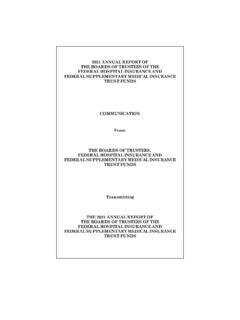Transcription of A HEALTH FINANCING REVIEW OF VIET NAM
1 A HEALTH FINANCING REVIEW OF VIET NAM WITH A FOCUS ON SOCIAL HEALTH INSURANCE Bottlenecks in institutional design and organizational practice of HEALTH FINANCING and options to accelerate progress towards universal coverage August 2011 by Tran Van Tien, Hoang Thi Phuong, Inke Mathauer and Nguyen Thi Kim Phuong ii Table of contents List of tables .. ii List of ii iii Acknowledgement .. iiv 1. Introduction .. 1 2. Overview of the HEALTH FINANCING system of Viet Nam .. 4 The structure of the HEALTH care system ..4 HEALTH FINANCING policies and the evolution of social HEALTH insurance .. 6 Resource mobilization and HEALTH expenditure.
2 9 3. HEALTH insurance in Viet Nam: institutional design, organizational practice, and challenges .. 13 Social HEALTH insurance enrolment and collection of contributions .. 14 Pooling of 22 Purchasing .. 24 HEALTH insurance benefit package and financial risk protection .. 24 Purchasing structure and provider payment mechanism .. 26 4. Summary of the HEALTH FINANCING performance assessment .. 35 5. Conclusions and 38 References .. 42 List of tables Table 1. Indicators of HEALTH FINANCING performance .. 2 Table 2. Current HEALTH insurance membership categories .. 16 Table 3. HEALTH insurance coverage 2010, by mode of 20 Table 4.
3 Share of total SHI contributions by membership 21 Table 5. Capitation rates of the six SHI membership groups in Kien Giang Province, 29 Table 6. Actual achievement in HEALTH FINANCING performance indicators .. 35 Table 7. Catastrophic expenditure and impoverishment by socioeconomic status, 37 List of figures Figure 1: The structure of the HEALTH care system in Vietnam .. 4 Figure 2: Channels of FINANCING sources for the Viet Nam HEALTH care system .. 8 Figure 3: Per capita HEALTH expenditure in Viet Nam (US$ current prices ), 1998 2008 .. 9 Figure 4: Share of sources of total HEALTH expenditure in 10 Figure 5: Tax-based FINANCING for HEALTH (in current and constant prcies) during 2002 2008 11 Figure 6: Trend in HEALTH FINANCING , 1999 - 2008.
4 12 Figure 7: Government expenditure for HEALTH (excluding SHI expenditure) compared to total HEALTH expenditure and total government expenditure .. 12 Figure 8: Membership group share, their contribution and expenditure share (2010).. 38 Annex Figure 1: Overview of the analytical iiiAbbreviations CHS commune HEALTH station DRG diagnosis-related group FFS fee for service GDP gross domestic product GGE general government expenditure GGHE general government HEALTH expenditure INN international nonproprietary name MoH Ministry of HEALTH MOLISA Ministry of Labour.
5 Invalids and Social Affairs NHA national HEALTH account OOP out-of-pocket (payment) PHI private HEALTH insurance PPC Provincial People s Committee SHI social HEALTH insurance THE total HEALTH expenditure VND Vietnamese dong
6 (currency) VSS Viet Nam Social Security WHO World HEALTH Organization ivAcknowledgement We thank the Ministry of HEALTH (MOH) who approved and supported this study. We likewise are very grateful to MOH and VSS officials for their collaboration and fruitful discussions of HEALTH FINANCING issues. We extend our gratitude to WHO Representative of Vietnam as well as the whole WHO Country Office team for their great assistance both technically and organizationally. Finally, thanks are extended to all respondents from the different organizations and departments who shared their insights and views on the Vietnamese HEALTH FINANCING system.
7 Valuable research assistance was provided by Friedrich Wittenbecher 11. Introduction Rationale and objectives of this report Many countries are working to establish a HEALTH FINANCING system that allows them to move towards universal coverage defined as access to key promotive, preventive, curative and rehabilitative HEALTH interventions for all at an affordable cost thereby achieving equity in access and financial risk protection as well as in HEALTH FINANCING (WHO, 2005). This is particularly challenging for low- and middle-income countries in light of their heavy reliance on out-of-pocket (OOP) payments for HEALTH care (WHO, 2010).
8 The challenge is to improve the HEALTH FINANCING system in order to achieve universal coverage as an overall policy goal. The Government of Vietnam is clearly committed to universal coverage and has approved a number of important laws relating to HEALTH FINANCING and HEALTH insurance. In addition to some good HEALTH indicators, there are impressive achievements as to Vietnam's HEALTH FINANCING , namely a population coverage rate of about 60%, continuous commitment to state subsidized premium payments, and developments in the payment system. Viet Nam s HEALTH FINANCING policy puts a strong emphasis on equity in HEALTH .
9 Shifting from a tax-based HEALTH FINANCING system, Viet Nam has been introducing social HEALTH insurance (SHI) since 1992. The country s HEALTH insurance law was promulgated in 2008, with the goal of universal coverage by 2014. Yet, the goal of universal coverage with SHI is challenging. As in other developing countries, the majority of Viet Nam s population works in the informal sector. The share of household out-of-pocket (OOP) payments for HEALTH , despite its rapid decrease in recent years, is still very high and accounts for some 55% of total HEALTH expenditure (THE). Despite these successes and achievements, there are a number of bottlenecks in institutional design and organizational practice.
10 These impede Vietnam from achieving the levels of HEALTH FINANCING performance that the country could potentially attain, given its resources and priorities, and are therefore of great concern with regard to achieving universal coverage. Based on the application of the OASIS1 approach (Mathauer/Carrin, 2011), this report describes the findings of an assessment of the current HEALTH FINANCING system in Viet Nam. The report provides a detailed analysis of Viet Nam s HEALTH FINANCING system by assessing the system s institutional design and organizational practice i n relation to the key HEALTH FINANCING functions of resource collection, pooling and purchasing and how these affect the performance of the system.










